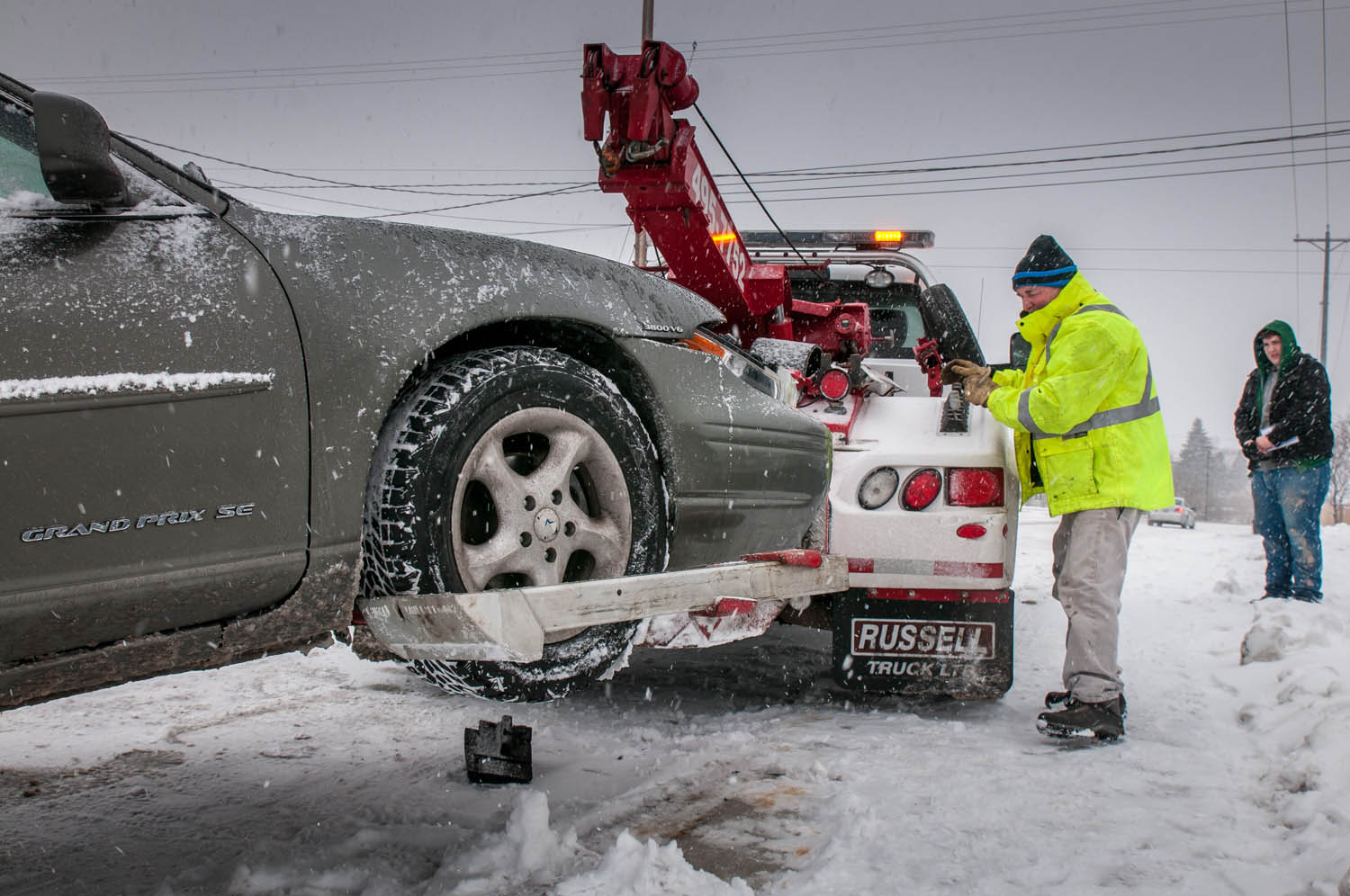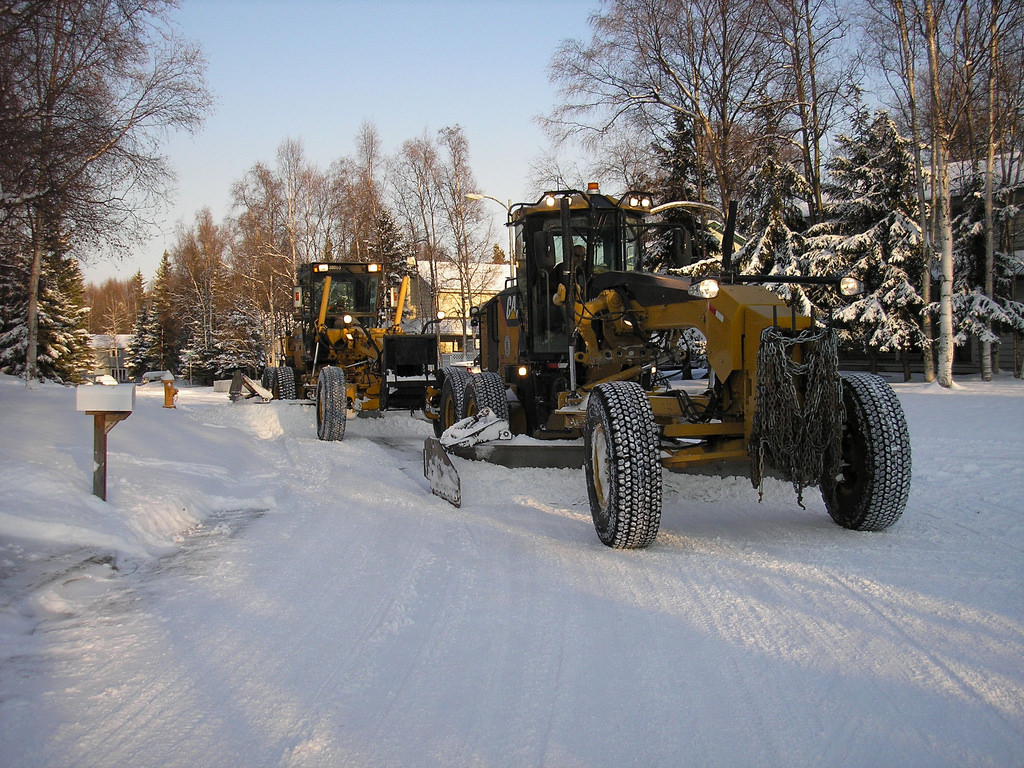November 11th, 2015
 Well, this sucks. Despite my previous excellent advice and helped along by slick road conditions, you’ve gotten stuck, or even slid into someone or something. (Or been slid into.) Great. Now what?
Well, this sucks. Despite my previous excellent advice and helped along by slick road conditions, you’ve gotten stuck, or even slid into someone or something. (Or been slid into.) Great. Now what?
First, of course, in the event of a collision, if you or anyone else involved has been injured, call 911. Or even if only your cars have been injured, call 911. If only your dignity has been injured, however, 911 doesn’t want to hear from you. If you’re in a city that requires it, like Anchorage (and there were no injuries), you’ll want to move the cars to a spot that doesn’t block traffic, such as a nearby parking lot. If you’re able, do all the normal post-collision stuff: call your insurance company, snap pictures of the accident, exchange information with the other driver, get statements from witnesses, post about your crappy day to Facebook. That kind of thing.
If you haven’t been in a collision but are merely stuck, you can call a tow truck, but you’ll feel mighty silly (and a little bit poorer) if the tow truck gets there and the driver hops in your car and simply drives it right back onto the road for you. So if you can do so safely, you should probably try to unstick yourself before admitting defeat. Here are some tips for doing just that.
- If you are anywhere where you might create a road hazard, put your emergency lights on. (Remember that winter conditions can make it harder for other drivers to spot you.)
- Clear any snow from in front of and behind your car with the snow shovel that of course is in your trunk. Break up ice with anything sharp you have available, being careful not to puncture the tires.
- While you’re out there: remove any snow, ice, or mud that might have gotten shoved into your exhaust pipe. Because carbon monoxide.
- If you’re by yourself, get back in the car, turn off electronic stability control if you’ve got it, and slowly, slowly (don’t jam on the gas) try to steer the car out of its current spot. If you can’t get immediately out, try going forward, then quickly reversing, then back and forth a few more times, also know as “rocking.” (Only try this a few times; too much and you can damage your transmission.) Sometimes this can get you just far enough out of the really slick spot.
- You can also use items to try to give your car traction: ice melt or kitty litter in front of/behind your tires, your car mats, even cardboard. I’ve successfully used cheap carpet mats that I happened to have on hand (I was stuck in front of my own driveway ... hey, it was really slick, and I lived on a hill!). Use what you’ve got as long as it won’t hurt your car, you, or anything else expensive.
- If you’ve got help, try having others push while you do all the above, if they can do it safely. IMPORTANT: Anyone pushing should be very careful not to exert themselves beyond what their bodies can handle. Every winter people die of heart attacks triggered by overexertion.
- Finally, once you get moving, don’t stop. Continue driving, slowly and safely—I know I keep using that word; that’s ‘cause “safely” is kind of a big deal—to your destination. Or back home. Back home is always a great option. I’m a big fan of back home. It usually has heat and warm beverages and wifi.
- Didn’t work, huh? Well, it happens. Time to call a tow truck. And post about the whole crappy day to Facebook.
That’s all for today. Next time we’ll talk about something a little more fun than the pain caused by eternal, endless, dark, dark winter. No, really. We will.
November 9th, 2015
 Winter weather has fully arrived and with it the Anchorage municipality is offering an online map tracking the city’s efforts to keep the roads clear.
Winter weather has fully arrived and with it the Anchorage municipality is offering an online map tracking the city’s efforts to keep the roads clear.
“We can’t control the weather, but our new map provides Anchorage residents with plow plans and real-time updates for roads the municipality maintains, as well as contact information for state-maintained arterials and streets,” Mayor Ethan Berkowitz said in a Monday statement announcing the new map.
City employees are responsible for approximately half of the paved roads in Anchorage—1,300 lane miles of road, 1,400 cul-de-sacs and 200 miles of sidewalks and trails.
Anchorage maintenance equipment included 30 graders, 9 sander truck and 2 de-icer vehicles.(2015)
Of note: Anchorage de-icer vehicles use magnesium chloride rather than salt (sodium chloride) due to environmental concerns. Saltwater runoff can contaminate soil and leach into rivers and lakes damaging salmon habitat. Electrolytes from saltwater increase the rate at which metals will rust.
Interactive map: Snow Plowing in Anchorage
November 4th, 2015
Brace yourselves! Winter is coming! No, not the fun Game of Thrones winter. The real deal: dark, endless Alaskan winter. Long, dreary, and cold. So cold. Cold, snowy, and icy. And you’ve got to drive in it. It’s not my idea of a good time and probably not yours either, but unless you have a half year of dry goods, bottled water, and toilet paper packed into the garage, plus a very understanding employer and really amazing wireless, you don’t have much choice. On the plus side, there are things you can do to make it a little less painful.
At this point, you’ve either switched to snow tires (legal starting September 15 in Anchorage) or you’re planning to make it through the season on all-weather radials. (If you’re still planning to switch to snow tires, you might want to get to it. Because … uh … WINTER IS COMING.)
Anyway, for the sake of this post, we’ll assume that you’ve got the tires you’ll have. Still, there’s some good prep you can do to keep yourself safe and warm and your car in good working order, which is the first step to a good driving experience. Safety first, kids! Before you get in the car (like, the day before):
- Those tires we were talking about? Make sure they’re properly inflated. Makes a huge difference in how the car handles, not to mention how long the tires last.
- Keep your gas tank at least half-full in cold weather to prevent the freezing of fuel lines.
- If you’re driving a diesel, make sure it stays warm enough to start by using block heaters and/or other methods.
- If you’re going to be driving out of town, it’s a good idea to have blankets, food, water, and any necessary medications in the car in case you get stuck.
And then shortly before you hop in your car to go:
- Never warm up your vehicle in an enclosed space like a garage. Because carbon monoxide.
- It’s also not a great idea to warm your car up outside by starting it and leaving the keys in it. That’s a good way to get your car stolen. A better option: remote start.
- Dress warmly, or at least take a coat and gloves with you. Maybe you’re just in town, but if it’s 15 degrees and you end up having to walk a half mile because you slid into a curb or ditch, a sweater isn’t going to cut it. You probably won’t freeze to death, but you’ll be pretty miserable, and you could end up with frostbite or worse.
Hey, you’re in your car, FINALLY!
- Great! Now, fasten your seat belts. Before you even shift into gear, make sure you and all your passengers are safely buckled in. I think most people do this by now, but a little reminder never hurt.
- Woo hoo! You’re moving! If you’re moving on snow or ice, though, go more slowly than usual. Allow more time for EVERYTHING because everything will take longer. (Just imagine snow and ice as a whiny toddler hanging on your legs as you try to walk. It’s like that.) Stopping. Starting. Turning. It’s just slower. Gentle pressure on the gas pedal, gentle pressure on the brakes.
- Speaking of stopping, don’t. If you can help it, don’t stop. Coming up to a red light? Slow down and see if you can hit it green. It’s much easier to keep going at a slow pace than to stop and start again on slick pavement. Inertia is a harsh mistress.
- But if you have to stop, in the name of all that you believe in, do not stop while going uphill. Do. Not. Just don’t.
- And perhaps most importantly: if you begin to slide into a curb or ditch or the nearest McDonald’s, avert your eyes! That’s right. Don’t look at the thing that your brain desperately wants you to look at. Point your eyes where you want to go (which typically would be the street). It’s science, people. Believe.
So, suppose you fail in your attempts and end up hitting another car or sliding into a ditch anyway. What now? Well ... now you wait until my next post. But seriously, try not to do that, k? Be safe.
Written by: Evelyn Stice
July 10th, 2015
As Anchorage celebrates its 100 years, we’d like to thank this great community for allowing Continental Subaru to serve you for all of your automotive needs. We feel very strongly about building on the legacy of our 3rd generation owned dealership, as our family maintains a strong tradition of giving back to the community we serve.
Continental Subaru goes beyond just doing business; we get involved in the community that has supported us since 1971. We are proud to support organizations working to strengthen our great Alaskan family – from local high school sports to community-minded organizations like the Nordic Skiing Association and the Eva Foundation. You’ve been here for us for the last 44 years Anchorage, and we’ll always be there for you.
Happy 100th Anchorage – and here’s to the next journey together!
 Well, this sucks. Despite my previous excellent advice and helped along by slick road conditions, you’ve gotten stuck, or even slid into someone or something. (Or been slid into.) Great. Now what?
Well, this sucks. Despite my previous excellent advice and helped along by slick road conditions, you’ve gotten stuck, or even slid into someone or something. (Or been slid into.) Great. Now what?
